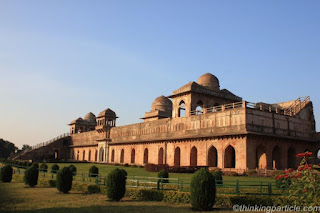The gates of palaces, forts, etc., fascinate me and I hold them the most important parts of the structure. The gates of forts, in the past centuries, played no less role in the case of wars. They had to be strong, sturdy and was good enough to withstand the impact caused by ramming of elephants. The decoration on such gates is a sign of elegance and affluence because the majesty of the inside structures in a kingdom can be gauged the way the entrance gates are designed and embellished with artistic works. In the by-gone era of uncertainty when invasions or raids by rulers against others were common, it was the gates that offered security and protection to the royal family as well as to the people living inside the fort. The historical gates of Mandu are unique aesthetically and architecturally built to safeguard the people living inside it.
Mandu in Dhar district of the Malwa region of western Madhya Pradesh was once a flourishing city, now an uninhabited place and is in ruins. Located at 35 km from Dhar city, it was part of the Tarangagadh or Taranga kingdom in the 11th century. The word "Mandu" is believed to be a corrupt form of "Mandapa Durga"in Prakrit. The inscription dating back to 612 VS (555 CE), suggests that Mandu was a thriving town in 6th century and later under the Paramaras it gained prominence in the 10th and 11th centuries.
In 1305, the Muslim ruler - Sultan of Delhi Alauddin Khalji (c 1267- 4 Jan. 1316) captured Malwa and cleansed the place and the Hindus were either killed or forced to convert to Islam. Being a fanatic Muslim ruler, he had no compassion for others, not to speak of his own relatives. A nephew and a son-in-law of his predecessor Jalaluddin, on 20 July 1296, Alauddin had Jalaluddin killed after pretending to greet the Sultan, and declared himself the new king. Jalaluddin's companions were also killed in the melee that followed. The unfortunate thing is Alauddin was so cruel, he openly paraded his father-in-law's severed head on a spear in his camp to create fear among his arch enemies; a tyrannical ruler, to whom compassion was an anathema. Later, this region was ruled by several Muslim rulers and the kingdom changed hands many times. Among the Muslim rulers, succession to the throne was marked by bloody violence and killing. After Mogul Emperor Akbar's quiet rule, this place came under the control of the Marathas.
Mandu is built on a hill top (altitude 633.7 m) 100 km from Indore city, covering a vast area of 20 sq in the Vindhayan Mountain range. The fortress town, once called the city of joy on a rocky outcrop is a historical place and is known for its architecture and workmanship, protected by 12 Darwazas. In the bygone-era it was a well fortified fort with thick walls, openings and necessary gates; they were built for both daily and military use. These heritage sites need protection and proper restoration, as they are the silent sentinels of various historical events that occurred in the forts, palaces, etc in the past. Most of them are in a damaged condition, Reason: Negligence on the part of governments (central and state), besides vagaries of weather, time, not to speak of vandalism by the anti-social people in the society
Separated from the main plateau of Malwa by a deep and wide ravine called Kakra Khoh encircling it, the fort was protected by a 45 km long rampart punctuated by 12 main gates namely, Alamgir Darwaza , Bhangi Darwaza , Kamani / Kabaani Darwaza , Gadi Darwaza , Delhi Darwaza , Rampol Darwaza , Tripoltya Darwaza , Tarapur Darwaza , Bhagwaniya Darwaza, Jahangirpur Darwaza
 |
| Jahaz Mahal, Mandu, MP. .thinkingparticle.com |
 |
| Alamgir gate, Mandu. indiaunveiled.in/ |
 |
| Alamgir Darwaza, Mandu, MP. en.wikipedia.org |
 |
| Kamani gate (Darwaza), Mandu. indiaunveiled.in |
 |
| Gadi Darwaza, Mandu,madhya pradesh en.wikipedia.org. |
 |
| Fort gate Mandu, MP. commons.wikimedia.org |
 |
| Dilli (Delhi) gate, Mandu. indiaunveiled.in/ |
 |
| Banghi gate,indiaunveiled.in |
 |
| Hathi gate, Mandu, Madhya Pradesh dreamstime.com |
 |
| Mandu, Madhya Pradesh Hathi Pol (gate), flickr.com |
Across Andheri and Ujali Baodis was Hathi Pol Darwaza guarded by two elephants. The images are damaged. The ruins of a lofty Tripoltya Darwaza is noticeable at Jami Masjid - in front of eastern facade of the mosque .
Bhagwania Darwaza, named after Bhagwanpur village (5 km from here), is in the south wall of the fort facing the Nimar valley and has two entrances, the inner being larger than the outer one. There are massive walls covering the uncovered passage between these two gates. There are security rooms with gabled roof.
 |
| .one of the gates, Mandu, Madhya Pradesh. in.pinterest.com |
 |
| Hathi Pol (gate), Mandu, Madhya Pradesh flickr.com |
Tarapur Darwaza is located on a 300 meter high hill top and the village Tarapur is in a quiet and serene place in the plains; tourists access the hill through stone-steps.
Jahangirpur Darwaza lies in the midst of a thickly forested area.The remains of damaged fort east and south are not easily accessible today because of thick forests.
https://timesofindia.indiatimes.com/travel/destinations/mandu-in-madhya-pradesh-is-a-romantic-treasure-waiting-to-be-explored/as71184021.cms
https://www.tripadvisor.in/ShowUserReviews-g319727-d6612207-r284195947-Darwazas_of_Mandu-Mandu_Dhar_District_Madhya_Pradesh.html#






.jfif)

.jfif)
